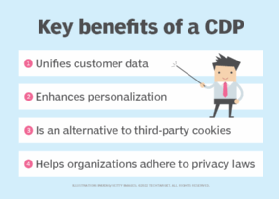
Getty Images/iStockphoto
4 benefits of a customer data platform
CDPs organize customer data to support personalized CX strategies and compliance. Benefits of CDPs include unified customer profiles and enhanced marketing efforts.
As organizations collect customer data across various touchpoints, CDPs can help them use and protect this information.
Organizations rely on customer data platforms to aggregate customer information into central repositories so they can easily manage and analyze it. These systems let users understand customers and group them into segments to enable personalized marketing. CDPs use first-party data, rather than third-party data, and they help compliance teams secure and govern sensitive customer information.
Explore four key benefits of CDPs, which include building unified customer profiles, enhancing marketing and support efforts, counteracting the deprecation of third-party cookies and ensuring compliance.
What is a CDP?
A CDP is a software system that aggregates customer data from different sources into a central repository. These systems use personally identifiable information (PII), such as email addresses and phone numbers, to match behavioral data with individual customers and build comprehensive customer profiles.
CDPs typically collect customer data from the following sources:
- CRM systems
- social media
- company websites
- mobile apps
- loyalty programs
- point-of-sale systems
- contact center software
4 benefits of a CDP
CDPs can centralize customer data, which can help unify customer profiles, enhance marketing and customer service, offers an alternative to third-party cookies and improves compliance with data privacy laws.
1. Builds unified customer profiles
As organizations interact with customers, they can gather valuable data to inform future business decisions. However, this data is often unorganized and siloed, as it comes from disparate channels. CDPs use APIs and SDKs to pull this data into a single location.
After CDPs collect data, they automatically cleanse it and perform an identity resolution process to link behavioral data to PII, like social media handles and IP addresses. This process creates unified customer profiles that marketing, sales, product development and customer support teams can use to understand their audiences.
A customer profile in a CDP may contain the following information:
- name
- phone number
- IP address
- age
- gender
- geographic location
- purchase history
- social media activity
- website engagement data
- contact center interactions
2. Improves marketing and customer service
CDPs can integrate with marketing and customer service technologies, so those teams can access detailed customer profiles from the tools they already use.
Marketing. Organizations typically serve a diverse array of customers and market toward people with different channel preferences, attitudes and product interests. To maximize a campaign's effectiveness, marketing teams can create different campaigns for different customer segments.

For instance, a sporting goods retailer may use customer profiles in a CDP to create a segment for fishing enthusiasts that prefer email communications. Campaigns for this segment may include automated emails that promote sales on lures, rods and other fishing equipment. As CDPs help marketers target their efforts, they can improve customer relationships and eventually increase their organizations' revenue.
Customer service. Customer service teams can also benefit from CDPs, because they help agents better understand customers. Organizations can integrate CDPs with contact center software, so agents can view customers' recent interactions with the contact center. This helps agents quickly understand the customers' issues so they won't need to repeat themselves.
3. Can replace third-party cookies
As Google plans to eliminate third-party cookies from its Chrome browser by late 2024 due to privacy concerns, CDPs can help marketers make the most of first-party data. First-party data refers to information that organizations collect directly from customers, as opposed to data from third-party cookies, which organizations use to track customers' browsing activity across the internet.
CDPs can aggregate and organize -- and, in some cases, analyze -- first-party data, so they can help marketers maintain personalization strategies without third-party cookies.
4. Ensures privacy compliance
Organizations must comply with data privacy legislation, such as the European Union's GDPR and California's CCPA, to build trust with customers and avoid fines. Under these laws, customers can request to see all the personal data an organization has related to them and how that company uses it. Additionally, organizations must delete this information if customers ask.
CDPs can help organizations comply with data privacy regulations because of their centralized data repositories. The CDP's centralized nature lets organizations manage, protect and audit sensitive customer information. For example, if a California resident requests to view all the personal information an online retailer has collected on them, the retailer can access that data from the customer's profile in the CDP and make it available to the customer.
As the multichannel marketing landscape expands and governing bodies enact stricter privacy laws, organizations must manage and protect customer data. Organizations that want to build strong customer relationships and maintain compliance should consider a CDP.







